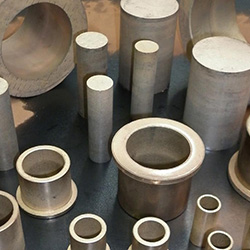Blog
Sintering and Sintered Components: What Is It All About?
April 20, 2017
 A description of sintering and sintered components takes us away from traditional metal casting technology. Instead, the parts are fabricated from compacted metal particles. In this process, a powdery alloy is subjected to high temperatures and crushing pressures until the aggregate mass assumes a solid shape. In the context of bearing technology, the sintering process presses the powder into compacted sleeves, a form that’s gifted with some interesting properties.
A description of sintering and sintered components takes us away from traditional metal casting technology. Instead, the parts are fabricated from compacted metal particles. In this process, a powdery alloy is subjected to high temperatures and crushing pressures until the aggregate mass assumes a solid shape. In the context of bearing technology, the sintering process presses the powder into compacted sleeves, a form that’s gifted with some interesting properties.
Sintering Starts With Metal Powder
A forging complex melts an alloy, pours the melt, and casts a part. Sintered components use a different fabrication path. They begin as a loose mass of metal particles. Transported into a furnace, the fine-grained aggregate bonds at a microscopic level, one particle to its neighbour, until the loose mix solidifies. Essentially, the tiny grains weld together until a solid mass is created, at which point a moulding press compacts and forms the bearing. That, in a nutshell, is a working example of sintering.
Porous Properties
If the processing environment is raised to just below the alloy’s melting temperature, the material is transformed. It leaves its powdery state and becomes solid, but this compacted form isn’t quite as dense as it seems. Granted, the newly manufactured bearing is hard enough to handle a heavy rotating load, but it still exhibits a measure of porosity. Invisible to the naked eye, the bonded metal particles have just enough space around their grainy outlines to allow another material admittance. We’re referring, of course, to the impregnated lubricants that exist inside sintered bearings. That’s right, this process imbues bushings and sleeved plain bearings with self-lubricating properties.
Lubricant-Impregnated Bearings
Contemporary rolling element families rely on moving parts, metal rings that cage sliding parts. Additionally, a film of oily liquid must be maintained inside these products. Paired with the rolling elements, the rings and oil keep friction at bay, even when a shaft’s rotational velocity or its load generate great stress. The sintering process offers another solution to this rubbing effect. Usually found in bronze products, the sleeved and sometimes flanged sintered components are composites. Back at the processing equipment, the powdery metal has been heated and mixed with a lubricating agent. This two-part mix was then compacted and pressed into a solid bearing. The result is an oil-impregnated friction handler, a bearing that doesn’t need any other machine elements.
Keep in mind the major differences in the sintering process. Forging and casting aren’t applicable fabrication techniques here, not when a metal powder is the source material. Heated and pressed, this micro-welded mix forms geometrically accurate and dimensionally stable bearings. Then, when a lubricating agent is added to that aggregate mix, the final result is a solid bearing that’s oil-impregnated and self-lubricating.
Optimized by: Netwizard SEO

